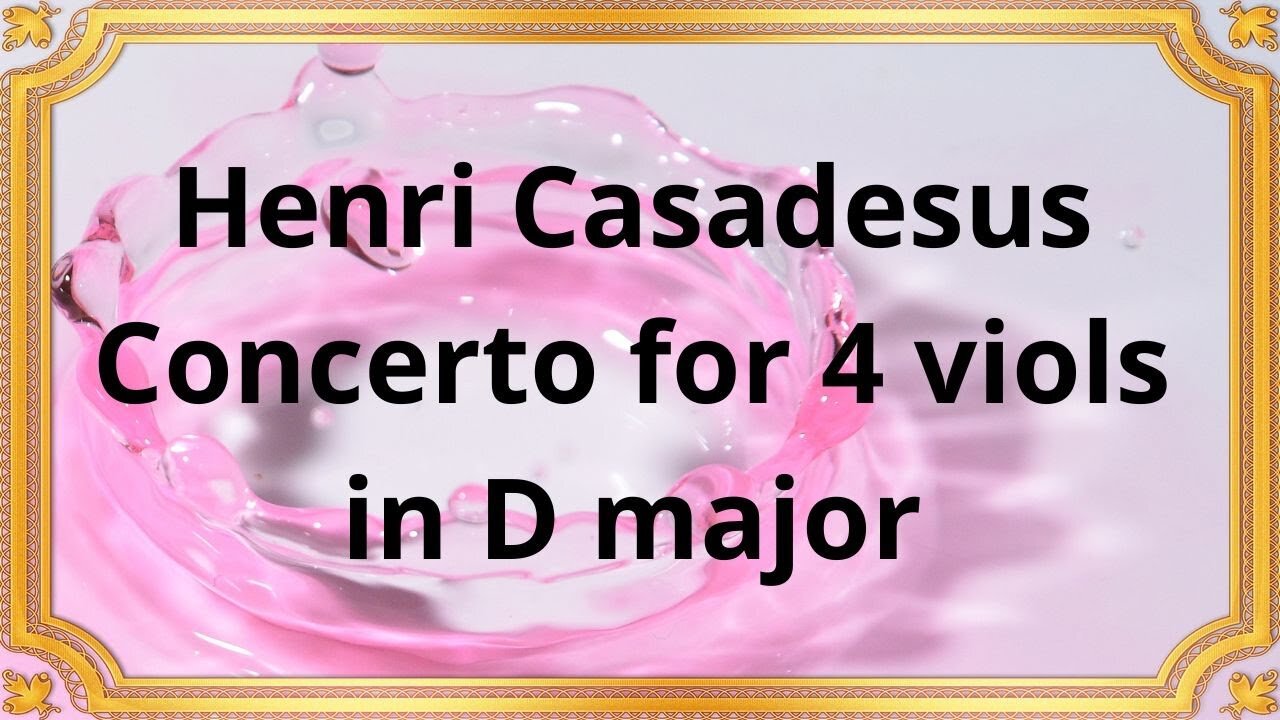Premium Only Content

Henri Casadesus Concerto for 4 viols in D major
#ClassicalMusic #HenriCasadesus #ConcertoFor4Viols #DMajor #BaroqueEra #StringInstruments #ChamberMusic #FrenchComposer #MusicalComposition #Virtuosity #MelodicRichness #HistoricalSignificance #StringEnsemble #ViolaDaGamba #StringQuartet #OrchestralWork #FrenchBaroque #BaroqueComposition
The world of classical music is adorned with countless masterpieces, each bearing the unique imprint of its composer. One such hidden gem is the Concerto for 4 Viols in D Major by Henri Casadesus.
Henri Casadesus, a French composer and violist of the 20th century, crafted his Concerto for 4 Viols in D Major as a tribute to the Baroque era. The concerto was composed in the 1930s, a time when there was a resurgence of interest in the Baroque style. This composition pays homage to the rich traditions of the past while infusing it with Casadesus's unique musical language.
The concerto follows the traditional three-movement structure of the Baroque concerto. It consists of an opening Allegro, followed by a contrasting slow movement (Adagio or Andante), and concludes with a lively and spirited finale.
Casadesus's concerto showcases his mastery of melodic writing. The four viols, in a unified ensemble, weave intricate and expressive melodies throughout the composition, creating a tapestry of sound that is both harmonically rich and emotionally captivating.
The Concerto for 4 Viols in D Major demands exceptional technical prowess from the performers. With its complex passages, intricate counterpoint, and challenging bowing techniques, this composition showcases the virtuosity of the violists and pushes the boundaries of their musical abilities.
Casadesus's Concerto for 4 Viols in D Major holds historical significance as it contributes to the revival of Baroque music in the 20th century. By composing this work, Casadesus not only pays homage to the Baroque masters but also adds his own creative flair, infusing the composition with a modern sensibility. It stands as a testament to the timeless elegance and beauty of Baroque music, bringing this style to a new generation of listeners.
Furthermore, this concerto has become an essential part of the viola repertoire, captivating both performers and audiences with its expressive melodies and technical challenges. It serves as a reminder of the versatility and expressive capabilities of the viola and highlights its importance as a solo instrument.
Conclusion:
Henri Casadesus's Concerto for 4 Viols in D Major stands as a testament to his artistic vision and his dedication to honoring the Baroque tradition. Through its melodic richness, technical demands, and historical significance, this composition has carved its place in the world of classical music. As we continue to explore the depths of musical genius, it is essential to rediscover and appreciate hidden treasures like Casadesus's concerto, which embody the timeless elegance and beauty of the Baroque era.
You have the opportunity to support the channel:
https://destream.net/live/RadSiarAl/donate
https://www.buymeacoffee.com/6355radsiaral
-
 31:06
31:06
Classical music_Music Inspiration
1 month agoPyotr Ilyich Tchaikovsky Piano Concerto No. 1 in B-flat minor
581 -
 LIVE
LIVE
Timcast
57 minutes agoNepal's Government COLLAPSES, Gen Z REVOLUTION Over Social Media Ban, 19 Dead
22,911 watching -
 LIVE
LIVE
Steven Crowder
3 hours ago🔴 Brian Stelter's Delusional Response to the Charlotte Stabbing is Everything Wrong With Media
24,530 watching -
 59:03
59:03
The Rubin Report
2 hours agoCharlie Kirk Notices Something in the Charlotte Stabbing That Most Are Afraid to Admit
17.1K34 -
 2:03:56
2:03:56
Benny Johnson
2 hours agoBOMBSHELL: Massive Judicial Corruption Scam That ALLOWED Black Killer to Murder in Charlotte EXPOSED
14.2K33 -
 13:24
13:24
Peter Boghossian
3 days agoWhy Can't TRANS People Answer This Simple Question, "What Is Trans?"
1882 -
 LIVE
LIVE
The Shannon Joy Show
1 hour ago🔥🔥Could Trump Trigger The Globalist Great Reset?🔥🔥
204 watching -
 LIVE
LIVE
Trumpet Daily
48 minutes agoTrumpet Daily LIVE | Sept. 9, 2025
416 watching -
 27:46
27:46
Rethinking the Dollar
1 hour agoUS Jobs Report DECEPTION – Precious Metals Smell Blood (Fed To Cut BIG) | Morning Check-In: Let's Talk...
5.58K2 -
 1:00:08
1:00:08
VINCE
3 hours agoBREAKING: Trump Goes To 'War' In Chicago | Episode 121 - 09/09/25
146K128